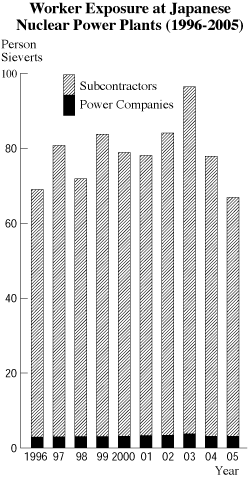In July, the Nuclear and Industrial Safety Agency (NISA) released data relating to worker radiation exposure and the management of radioactive waste at nuclear facilities for the 2005 fiscal year (ending 31 March 2006). The data covers nuclear power reactors, nuclear fuel related facilities and radioactive waste facilities.
With the start-up of the Shika-3 reactor, the number of nuclear power reactors increased to 55. Total collective dose at nuclear power plants in FY 2005 was 67.07 person-sieverts compared to 78.23 person-sieverts in FY 2004.
 All 216 people who received doses in the 15-20 milli-sievert (mSv) range were sub-contractor workers. The highest dose was 19.4 mSv at Kashiwazaki-Kariwa. By contrast, figures published by the Radiation Dose Registration Center (part of the Radiation Effects Association) were much higher. This is because these figures take into account the fact that some people worked at more than one nuclear power plant. According to these figures, 409 people received doses in the 15-20 mSv range and one person (working at two plants) received a dose in the 20-25 mSv range. The average exposure of people working at a single plant was 0.6 mSv. The average increases to 2.1 mSv for people working at two plants, 2.9 mSv at three plants, 3.6 mSv at four plants, and 4.1 mSv for people working at five or more plants. Subcontractor workers received 95% of the total collective dose was. The highest dose for an employee of a nuclear power company was 11.8 mSv at Ohi.
All 216 people who received doses in the 15-20 milli-sievert (mSv) range were sub-contractor workers. The highest dose was 19.4 mSv at Kashiwazaki-Kariwa. By contrast, figures published by the Radiation Dose Registration Center (part of the Radiation Effects Association) were much higher. This is because these figures take into account the fact that some people worked at more than one nuclear power plant. According to these figures, 409 people received doses in the 15-20 mSv range and one person (working at two plants) received a dose in the 20-25 mSv range. The average exposure of people working at a single plant was 0.6 mSv. The average increases to 2.1 mSv for people working at two plants, 2.9 mSv at three plants, 3.6 mSv at four plants, and 4.1 mSv for people working at five or more plants. Subcontractor workers received 95% of the total collective dose was. The highest dose for an employee of a nuclear power company was 11.8 mSv at Ohi.
Epidemiological studies on workers at Japan's nuclear power plants are based on records kept by the Radiation Dose Registration Center. The Ministry of Education, Culture, Sports, Science and Technology (MEXT) published a study in February (report for the third period: 2000-04) which acknowledged a direct correlation between dose and incidence of cancer of the esophagus, lung cancer, multiple myeloma, etc.. Nevertheless, the report concludes, "No clear evidence that low doses of radiation have an effect on the rate of cancer deaths was found." The Radiation Effects Association has conducted this epidemiological study on behalf of MEXT since 1990 through funding under the Special Budget Law for the Development of Electric Power.

